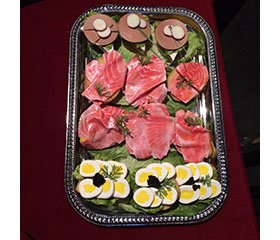Were I forced to shape a TV reality show around just one backstage professional, I would have to choose the props supervisor. He or she has to combine the skills of an art historian, a crafts expert, and an online shopper. The process by which some items are located would be part “Antiques Roadshow,” part “Hoarders,” and part “Martha Stewart Living” – with a touch of “The Amazing Race” thrown in.
For Oslo, the person wearing all these hats is props supervisor Faye Armon-Troncoso. A veteran of many LCT shows – War Horse, Golden Boy, Macbeth – Armon-Troncoso told me the other day how she found some of loveliest items for J.T. Rogers’ play about peace talks between Israelis and Palestinians. A large wooden table, for example.
“We call it the negotiating table,” she said. “We looked at 20 or 30 tables before we chose one. We try to find things within a 100-mile radius of New York, so we don’t have to go far to pick them up.” In this case, the prop was in fetching distance, but there was a hitch. “It was a listing on eBay. The woman who owned the table said it was being shipped to an antiques fair faraway. I said, ‘If it doesn’t sell, could we have it then?’ She said okay. The table didn’t sell so we got it.”
But there was a problem. “The table has cabriole legs,” Armon-Troncoso said. “Everything has to be moved on and off stage, and must roll perfectly. The set has wood-plank floors. What would happen if one of the legs got caught in a gap between the planks?” Ever-resourceful, she called in a caster specialist. “We figured it out,” she said.
Armon-Troncoso told me that everything in a play other than walls and floors and built-in cabinetry – anything that can move or that the actors touch -- can be considered a prop. “Oslo has 53 scenes,” she said, “which means that almost everything in the play falls under my jurisdiction.” (Within any production’s collaborative process, of course: the props supervisor works closely with the set designer and the director and the actors.)
Armon-Troncoso has been overseeing her domain for around 18 years. She began while working at New York’s Cherry Lane Theatre, where she was an assistant manager. “I saw a prop girl running around and I thought that I’d like to try that,” Armon-Troncoso said. In 2004, after working on a production of Tracy Letts’ play Bug, she became the only props person to win an Obie, a distinction that held until this year. “Props people don’t normally win awards,” she said. “Most theatergoers have no idea of the variety of the tasks we are called upon to do.”
With Bug, for example, the director wanted crack pipes. “He didn’t want standard paraphernalia,” she said. “I had to go undercover to smoke shops, to look things over. I discovered glass tubes with paper or plastic roses inside of them. Those are crack pipes. Who knew?”
I asked Armon-Troncoso if she had a favorite prop in Oslo. “Yes,” she replied immediately. “The silver sandwich tray.” There had been a sandwich tray in J. T. Rogers’ previous LCT play, Blood and Gifts, so she had some familiarity with the item. “When I research a production, I try to be true to location and period. So, this time, I had to research Norwegian trays.” That wasn’t all: she had to figure out the Norwegian delicacies – salmon and caviar and eggs and bread – that went on the tray. “We made the salmon with paper and glue and gloss,” she explained. “And we made the eggs out of clay.” The latter props weren’t too difficult. “One of the first props I ever made in my career were eggs,” Armon-Troncoso said. “I know a whole lot about them.”
Brendan Lemon is the editor of lemonwade.com.
